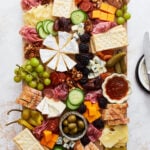Gluten-Free Charcuterie Board
I always create a gluten-free charcuterie board for my dinner parties and holidays, which never fails to earn endless compliments. These stunning boards combine a variety of textures and flavor profiles, making them one of the easiest yet most impressive appetizers to prepare. Perfect for any occasion, I’ll guide you step by step to craft your next show-stopping cheeseboard.
Servings: 6 servings
Ingredients
Cheese
- 1 cup cheddar cubed
- 1 brie wheel or camembert
- 1/2 cup blue cheese
- 1/2 cup gouda sliced, or other Swiss cheese
Meats
- 6 slices prosciutto
- 12 slices salami
- 1/2 cup chorizo sliced
Crackers & Bread
- 1 1/2 cups gluten-free crackers
- 1 1/2 cups gluten-free baguette sliced
Fruits & Vegetables
- 1/2 cup grapes fresh, red or green
- 1/2 cup blackberries fresh
- 1/4 cup dried apricots
- 1/4 cup dates
- 1/2 cup cucumbers sliced
Pickles Vegetables
- 1/4 cup olives
- 1/4 cup baby dill pickles
- 1/4 cup pepperoncini peppers
Nuts & Jams
- 1/2 cup roasted walnuts
- 4 tablespoons apricot jam
Instructions
- Arrange cheeses on the board first, spreading them out to anchor the layout.
- Add meats, folding or rolling them for presentation.
- Place crackers and gluten-free bread around the edges.
- Fill gaps with fresh fruit, dried fruit, and sliced veggies.
- Scatter nuts and pickled vegetables around the board.
- Add jam to a small dish and place on the board as well.
- Serve immediately, or cover and refrigerate until ready to serve.
Notes
- I always check the packaging for gluten-free certification, especially for crackers, bread, cured meats, and spreads. Avoid cross-contamination if preparing alongside gluten-containing items.
- My top tip for creating a styled charcuterie board is to plan it out. Plan what you want on the board and begin by visualizing your board divided into quadrants and work in sections. I like to make sure there are meats, cheeses, and crackers in each section. This helps to evenly style out the board.
- Some of my favorite fruit add-ons are grapes, berries, dried apricots, figs, dates, apple slices, and pear slices.
- Toss apple or pear slices in lemon water to prevent browning before adding them to the board.
- Some great dips and jams to add to the board are honey, jam, chutney, hummus, pesto, or gluten-free mustard add variety to the board.
- Use any nuts you like, such as cashews, pecans, hazelnuts, or pistachios. Offer a mix of salted and unsalted varieties for balance.
- Choose a mix of hard, soft, and semi-soft cheeses for variety.
- Store each element of the board individually. Cheese, meats, fresh fruits, and vegetables should be stored in the refrigerator. Bread and crackers should be stored in airtight containers in the pantry, and any accouterments should be stored however they were stored before assembly
Nutrition
Serving: 1serving | Calories: 1027kcal | Carbohydrates: 98g | Protein: 34g | Fat: 55g | Saturated Fat: 25g | Polyunsaturated Fat: 7g | Monounsaturated Fat: 13g | Trans Fat: 0.01g | Cholesterol: 113mg | Sodium: 2202mg | Potassium: 514mg | Fiber: 6g | Sugar: 19g | Vitamin A: 964IU | Vitamin C: 9mg | Calcium: 492mg | Iron: 4mg
